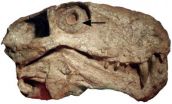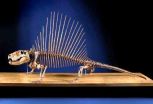(Press-News.org) Most living mammals are active at night (or nocturnal), and many other mammal species are active during twilight conditions. It has long been thought that the transition to nocturnality occurred at about the same time as mammals evolved, around 200 million years ago. This thinking was based on on features such as the large brains of mammals (good for processing information from senses like hearing, touch, and smell) and the details of light-sensitive chemicals in the eyes of mammals.
It turns out that nocturnal activity might have a much older origin among ancient mammal relatives, called synapsids.
"Synapsids are most common in the fossil record between about 315 million years ago and 200 million years ago. The conventional wisdom has always been that they were active during the day (or diurnal), but we never had hard evidence to say that this was definitely the case," says Kenneth Angielczyk, a curator at The Field Museum. He's the lead author of a paper appearing September 3 in the early edition of Proceedings of the Royal Society B entitled "Nocturnality in Synapsids Predates the Origin of Mammals by 100 Million Years."
The new insights come from an analysis of tiny bones, called scleral ossicles, that are found in the eyes of many backboned animals, including birds and lizards. Living mammals lack scleral ossicles, but they were present in many of their ancient synapsid relatives. "The scleral ossicles tell us about the size and shape of different parts of the eyeball," said Lars Schmitz, a professor of biology at Claremont McKenna, Pitzer, and Scripps Colleges, located near Los Angeles. "In turn, this information allows us to make predictions about the light sensitivity of the eye, which usually reflects the time of day an animal is active.
Because scleral ossicles are very delicate, they usually aren't preserved in synapsid fossils. However, by scouring museum collections in the United States and South Africa, and with help from other paleontologists, Angielczyk and Schmitz were able to collect data on scleral ossicles from 24 species that represent most major groups of synapsids. The synapsid data were then compared to a large dataset of similar measurements for living lizards and birds that have known daily activity patterns, using a statistical technique developed by Schmitz.
The technique revealed that the eyes of ancient synapsid species likely spanned a wide range of light sensitivities, with some consistent with activity under bright conditions during the day and others having eyes best suited to low-light conditions at night. Of particular interest was the fact that the oldest synapsids in the dataset, including the famous sail-backed carnivore Dimetrodon, were found to have eye dimensions consistent with activity at night. Based on the ages of the rocks in which these fossils are found, the results indicate that nocturnality had evolved in at least some synapsids by about 300 million years ago, or 100 million years earlier than the age of the first mammals. Indeed, Angielczyk and Schmitz's results raise the possibility that the common ancestor of all synapsids was active at night.
"The idea of a nocturnal Dimetrodon was very surprising," said Angielczyk, "but it shows how little we really known about the daily lives of some of our oldest relatives." "This is the first time we can make informed predictions about the activity patterns of synapsids," added Schmitz. "As we discover more fossils, we can continue to test these predictions and start to address questions such as how many times nocturnality evolved in synapsids and whether the synapsids most closely related to mammals were also nocturnal."
The results should be useful to researchers studying the visual systems and behavior of living mammals, and they also will necessitate the rethinking of some long-held ideas, such as mammals becoming nocturnal to avoid competition with dinosaurs.
INFORMATION:
FAQ: Nocturnality in Synapsids Predates the Origin of Mammals by Over 100 Million Years
This fact sheet was developed by co-authors of "Nocturnality in Synapsids Predates the Origin of Mammals by Over 100 Million Years," being published the week of September 3 in the early edition of Proceedings of the Royal Society B.
Major Findings
1) The eyes of ancient synapsids covered the full spectrum of light sensitivities seen in living aninmals, with some species having eyes best suited to activity under bright conditions during the day, others having eyes best suited to low-light conditions at night, and still others having eyes suited to activity under twilight conditions.
2) The eyes of the oldest synapsids species considered in the study, which are about 300 million years old, are predicted to have been best suited to activity under low light conditions at night. These animals are about 100 million years older than the oldest fossils of mammals.
3) The common ancestor of all synapsids (including living mammals) may have been nocturnal (active at night).
4) Most plant-eating synapsids that were included in the study are predicted to have been active during the day.
5) Nocturnality may have evolved multiple times in synapsids.
Facts About Synapsids
Synapsida is a large group of backboned animals that live on land.
Synapsids include all living mammals, as well as many extinct mammal relatives.
All fossil synapsids are more closely related to living mammals than they are to any amphibians, reptiles, or birds.
The oldest fossil synapsids are about 315 million years old.
The first mammals evolved about 200 million years ago.
Famous fossil synapsids include the sail-backed predator Dimetrodon (from the Permian Period of Earth history) and Lystrosaurus (from the Triassic Period of Earth History).
Facts About Daily Activity Patterns
Animals that are mainly active during the day are diurnal.
Animals that are mainly active at night are nocturnal.
About 45-55% of living land mammals are nocturnal, and many others are active under twilight conditions.
The light sensitivity of an animal's eyes often reflects their daily activity patterns.
The size and shape of various parts of the eye can be used to predict its light sensitivity.
Scleral ossicles are tiny bones that are found in the eyes of many backboned animals, including birds and lizards. Measurements of the scleral ossicles can be used to make predictions about the light sensitivity of an animal's eyes.
Living mammals do not have scleral ossicles, but the are present in many groups of fossil synapsids.
Scleral ossicles are very delicate, so they often are not preserved in fossils. Therefore, fossil synapsid specimens that preserve scleral ossicles are very rare.
Age
The fossils in this study come from the Permian and Jurassic periods of Earth history.
The Permian Period lasted from 299 million years ago to 252 million years ago
The Jurassic Period lasted from 201 million years ago to 145 million years ago.
The Permian fossils used in this study range in age from about 295 million years ago to about 252 million years ago.
The Jurassic fossils used in this study are about 200 million years old.
The oldest synapsid fossils are about 315 million years old (from the Carboniferous Period of Earth history).
The oldest mammal fossils are about 200 million years old (from near the boundary of the Triassic and Jurassic periods of Earth history).
Geography
Most of the specimens used in this study came from the united Sates (Texas and New Mexico), and South Africa.
Additional specimens used in this study are from Brazil, Russia, and Zambia.
Our Paper Does not Say
that all synapsids were nocturnal.
that all synapsids were diurnal.
whether the most recent common ancestor of living mammals was nocturnal or diurnal.
Funding
This study was funded by the Geology Department of the Field Museum of Natural History.
Potential Commentators (not affiliated with this research)
Jörg Fröbisch, Humboldt University (joerg.froebisch@mfn-berlin.de)
James Hopson, University of Chicago (jhopson@uchicago.edu)
Christian Kammerer, Humbolt University (christian.kammerer@mfn-berlin.de)
Ryosuke Motani, University of California, Davis (rmotani@ucdavis.edu)
Robert Reisz, University of Toronto (robert.reisz@utoronto.ca)
Bruce Rubidge, University of the Witwatersrand (bruce.rubidge@wits.ac.za)
Christian Sidor, University of Washington (casidor@uwashington.edu)
Stuart Sumida, California State University San Bernardino (ssumida@csusb.edu)
Ancient mammal relatives were active at night 100 million years before origin of mammals
2014-09-04
ELSE PRESS RELEASES FROM THIS DATE:
E-cigarettes may promote illicit drug use and addiction
2014-09-04
VIDEO:
Columbia researchers discuss how e-cigarettes may promote illicit drug use and addiction.
Click here for more information.
NEW YORK, NY (September 3, 2014)—Like conventional cigarettes, electronic cigarettes (or
e-cigarettes) may function as a "gateway drug"—a drug that lowers the threshold for addiction to
other substances, such as marijuana and cocaine—according to the 120th Shattuck lecture, presented to the Massachusetts Medical Society by Columbia researchers ...
Blood test for 'nicked' protein predicts prostate cancer treatment response
2014-09-04
Prostate cancer patients whose tumors contain a shortened protein called AR-V7, which can be detected in the blood, are less likely to respond to two widely used drugs for metastatic prostate cancer, according to results of a study led by researchers at the Johns Hopkins Kimmel Cancer Center. If large-scale studies validate the findings, the investigators say men with detectable blood levels of AR-V7 should avoid these two drugs and instead take other medicines to treat their prostate cancer. A report on the work is described online Sept. 3 in the New England Journal of ...
Airline pilots, cabin crews have higher incidence of melanoma
2014-09-03
Bottom Line: Airline pilots and cabin crews appear to have twice the incidence of melanoma as the general population.
Author: Martina Sanlorenzo, M.D., of the University of California, San Francisco, and colleagues.
Background: Melanoma is a common cancer in the United States; in 2014, 76,100 people will be diagnosed with the skin cancer and 9,710 people will die. Several studies have suggested a higher incidence of melanoma in pilots and flight crew. Flight-based workers are thought to have a greater occupational hazard risk of melanoma because of increased altitude-related ...
Obsessive compulsive disorder diagnosis linked to higher rates of schizophrenia
2014-09-03
Bottom Line: A diagnosis of obsessive-compulsive disorder (OCD) appears to be associated with higher rates of schizophrenia and schizophrenia spectrum disorders.
Authors: Sandra M. Meier, Ph.D., of Aarhus University, Denmark, and colleagues.
Background: OCD and schizophrenia are distinct and infrequently overlapping disorders. But some studies have suggested higher rates of co-existing illness with the two disorders in patients.
How the Study Was Conducted: The authors assessed the potential relationship between the two disorders using data from Danish registers. ...
Genetic 'hotspot' linked to endometrial cancer aggressiveness
2014-09-03
Parents of twins often tell them apart through subtle differences such as facial expression, moles, voice tone and gait. Similarly, physicians treating women with endometrial cancer must be able to distinguish between different versions of this disease form that, on the surface, appear the same.
With endometrial cancer, the most common gynecological cancer in the western world and the fourth most prevalent in the U.S., it can literally be a matter of life and death. Mortality rates from this cancer have nearly tripled in the last 25 years and are thought to be attributed ...
Can sleep loss affect your brain size?
2014-09-03
MINNEAPOLIS – Sleep difficulties may be linked to faster rates of decline in brain volume, according to a study published in the September 3, 2014, online issue of Neurology®, the medical journal of the American Academy of Neurology.
Sleep has been proposed to be "the brain's housekeeper", serving to repair and restore the brain.
The study included 147 adults 20 and 84 years old. Researchers examined the link between sleep difficulties, such as having trouble falling asleep or staying asleep at night, and brain volume.
All participants underwent two MRI brain scans, ...
Polyester clothes stink after exercise; cotton, not so much
2014-09-03
Polyester clothes smell worse than cotton, following intensive exercise by their wearers, because bacteria that cause odor grow better on polyester, according to research published ahead of print in the journal Applied and Environmental Microbiology.
In the study, the investigators collected t-shirts from 26 healthy individuals following an intensive, hour-long bicycle spinning session, and incubated the shirts for 28 hours before having them inspected by a trained odor panel. The researchers also investigated the taxonomy of the bacteria on the shirts, and in the axillaries. ...
NASA's HS3 hurricane mission and Terra satellite take on Tropical Storm Dolly
2014-09-03
NASA has Tropical Storm Dolly covered by satellite and the remotely piloted Global Hawk aircraft. Both captured data on Dolly before it made landfall in eastern Mexico.
The MODIS or Moderate Resolution Imaging Spectroradiometer instrument aboard NASA's Terra satellite took an image of Tropical Storms Norbert in the Eastern Pacific and Dolly in the Gulf of Mexico at 1:30 p.m. EDT on Sept. 2. The image showed Dolly is a much more organized storm than Norbert, and revealed Dolly's strongest, towering thunderstorms around the center of circulation. Norbert is close to the ...
Researchers discover new clues to determining the solar cycle
2014-09-03
Approximately every 11 years, the sun undergoes a complete personality change from quiet and calm to violently active. The height of the sun's activity, known as solar maximum, is a time of numerous sunspots, punctuated with profound eruptions that send radiation and solar particles out into the far reaches of space.
However, the timing of the solar cycle is far from precise. Since humans began regularly recording sunspots in the 17th century, the time between successive solar maxima has been as short as nine years, but as long as 14, making it hard to determine its cause. ...
NASA sees Tropical Storm Norbert affecting Mexico's west coast
2014-09-03
Tropical Storm Norbert has now triggered Tropical Storm Warnings for Mexico's West Coast, and NASA's Terra satellite showed how close it is to land.
On Wednesday, September 3, the National Hurricane Center (NHC) issued a Tropical Storm Warning from La Paz to Santa Fe, Mexico. There is also a Tropical Storm Watch in effect from north of Santa Fe northward to Cabo San Lazaro, Mexico.
he MODIS or Moderate Resolution Imaging Spectroradiometer instrument aboard NASA's Terra satellite took an image of Tropical Storms Norbert in the Eastern Pacific and Dolly in the Gulf of ...







